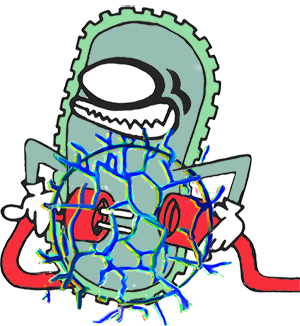Team:TU Delft-Leiden/WetLab/landmine/cloning
From 2014.igem.org
Dschmieden (Talk | contribs) |
Dschmieden (Talk | contribs) |
||
| Line 18: | Line 18: | ||
</ul> | </ul> | ||
</div> | </div> | ||
| - | + | ||
| - | + | <div class="clear"></div> | |
| - | + | ||
| - | + | <div class="tableofcontents"> | |
| - | + | <h3>Content</h3> | |
| - | + | <p> | |
| - | + | These Biobricks contain promoters activated in presence of landmine compounts: | |
| - | + | </p> | |
| - | + | <ul> | |
| - | + | <li><a href="/Team:TU_Delft-Leiden/WetLab/landmine/cloning#yqjF promoter">yqjF</a></li> | |
| - | + | <li><a href="/Team:TU_Delft-Leiden/WetLab/landmine/cloning#ybiJ promoter">ybiJ</a></li> | |
| - | + | <li><a href="/Team:TU_Delft-Leiden/WetLab/landmine/cloning#yqjF_and_ybiJ">Combination of yqjF and ybiJ</a></li> | |
| - | + | </ul> | |
| - | + | </div> | |
| - | + | ||
| - | + | ||
| - | </ | + | |
| - | </ | + | |
| - | + | ||
<a name="yqjF promoter"></a> | <a name="yqjF promoter"></a> | ||
Revision as of 13:57, 16 October 2014
Landmine Detection – Cloning

Landmine Detection
Content
These Biobricks contain promoters activated in presence of landmine compounts:
yqjF promoter
Final constructs
Two final constructs are based on the yqjF promoter alone: BBa_K1316003 and BBa_K1316007 (figures 1 and 2).


Cloning Scheme
For both BioBricks BBa_K1316003 and BBa_K1316007 the reporter gene mKate2 needs to be present behind the yqjF promoter. When the RNA polymerase binds to a promoter it keeps on transcribing DNA into mRNA until it falls out due to a transcriptional terminator or due to spontaneous detachment from the DNA. Therefore, a double transcriptional terminator was designed to be after the mKate2 gene. Otherwise, in the construct BBa_K1316007 the RNA polymerase would continue transcribing some unfinished transcripts of the N-genes could interfere with the normal expression of these genes. Therefore, mKate2 gene was first PCRed out of a comercial plasmid and introduced in front of a Double terminator ( BBa_K823017 ).
The yqjF land mine promoter was PCRed out of the plasmid obtained from Belkin's lab [1] and cloned in front of mKate2.
The construct BBa_K1316007 contains three genes (N-genes) assumed to be involved in the degradation of nitrogene compounds and, therefore, it was hypothesised that they could enhance the action of the used promoters (yqjF and ybiJ). These genes were synthesised de novo and cloned behind the double terminator. These genes were designed under the regulation of the Rhamnose inducible promoter, so that the influence of these N-genes can be easily tested.
A more graphical representation of the cloning strategy can be found on figure 3.

ybiJ promoter
Final constructs
Two final constructs are based on the ybiJ promoter alone: BBa_K1316005 and BBa_K1316008.


Cloning Scheme
For both constructs the reporter gene mKate2 needs to be present behind the ybiJ promoter. For the same reason explained for BBa_K1316003 and BBa_K1316007, a double transcriptional terminator was designed to be after the mKate2 gene. Therefore, mKate2 gene was first PCRed out of a comercial plasmid and introduced in front of a Double terminator ( BBa_K823017 ).
The ybiJ land mine promoter was PCRed out of the plasmid obtained from Belkin's lab [1] and cloned in front of mKate2.
The construct BBa_K1316008 contains three genes (N-genes) assumed to be involved in the degradation of nitrogene compounds and, therefore, it was hypothesised that they could enhance the action of the used promoters (yqjF and ybiJ). These genes were synthesised de novo and cloned behind the double terminator. These genes were designed under the regulation of the Rhamnose inducible promoter, so that the influence of these N-genes can be easily tested.
A more graphical representation of the cloning strategy can be found on figure 6.

Combination of yqjF and ybiJ
Final construct
The final construct is the BBa_K1316009 BioBrick, and it contains two copies of mKate2 regulated with one of the two studied promoters (yqjF and ybiJ) each (figure 7).

Cloning Scheme
For this construct BBa_K1316009, again, having a double transcriptional terminator between both coding sequences is important to prevent the formation of non-desired unfinished transcripts. In this case, the combination p[yqjF]-mKate2-TT-p[ybiJ]-mKate2 (being TT the double terminator) was created by restriction of "p[ybiJ]-mKate2" from BBa_K1316005 using XbaI and PstI and ligating it to BBa_K1316003 cut with SpeI and PstI, as shown on figure 8 . Nevertheless, having a double terminator behind BBa_K1316005 also allows for the formation of the contruct: p[ybiJ]-mKate2-TT-p[yqjF]-mKate2.
Containing both promoters, this construct aims at triggering a better response in presence of the chemical compounds desired to be detected (2,4-DNT and 1,3-DNB).
A more graphical representation of the cloning strategy can be found on figure 8.
 Figure 8: Cloning scheme for the constructs based on the combination of the yqjF and ybiJ promoters.
Figure 8: Cloning scheme for the constructs based on the combination of the yqjF and ybiJ promoters.
References
[1] S. Yagur-Kroll, S. Belkin et al., “Escherichia Coli bioreporters for the detection of 2,4-dinitrotoluene and 2,4,6-trinitrotoluene”, Appl. Microbiol. Biotechnol. 98, 885-895, 2014.
 "
"






